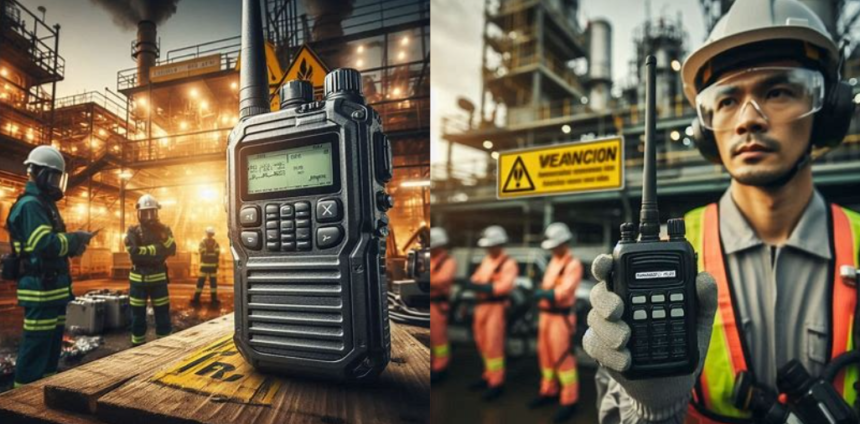In hazardous work environments, communication is key, but using standard electronic devices can pose serious risks. That’s where intrinsically safe radios come into play. Designed to prevent ignition in explosive atmospheres, these specialized two-way radios are a critical safety tool in industries like oil and gas, mining, and manufacturing.
These devices are specifically engineered to operate in environments where the presence of flammable gases, vapors, or dust could lead to catastrophic explosions if a spark or excessive heat were produced. Understanding the significance of IS radios, their components, and certifications is essential for industries that rely on safe and efficient communication systems.
What Are Intrinsically Safe Radios?
IS radios are designed with low-energy circuits that limit electrical and thermal energy to prevent combustion. They use special enclosures, batteries, and components to ensure they remain safe even in extreme conditions. The fundamental principle behind their safety lies in controlling the energy stored and released by the device.
Every component, from the wiring to the battery, undergoes rigorous testing to ensure it cannot generate a high enough temperature or electrical charge to cause ignition. Moreover, these radios often feature reinforced outer casings to withstand extreme environmental conditions, preventing any accidental breakage that could expose internal wiring.
Why Are Intrinsically Safe Radios Important?
- Prevent Explosions: These radios eliminate the risk of ignition in volatile environments, making them indispensable in industries dealing with hazardous materials. Without IS radios, workers in explosive atmospheres would have to rely on outdated and inefficient communication methods, which could increase operational risks.
- Ensure Compliance: Many industries are legally required to use IS-certified devices as per local and international safety standards. Regulatory bodies impose stringent guidelines on companies working in high-risk environments to ensure they adopt equipment that prioritizes worker safety.
- Enhance Worker Safety: Reliable communication is essential in high-risk areas to prevent accidents. In industries like chemical plants, where toxic gas leaks are possible, IS radios enable real-time coordination and response, potentially saving lives.
- Reduce Equipment Damage: Standard radios can overheat or spark, causing significant damage. Unlike IS radios, which are designed to operate safely under hazardous conditions, conventional radios pose a significant fire risk when exposed to combustible substances.
Industries That Require Intrinsically Safe Radios
Oil and Gas Industry
Workers in oil refineries, offshore drilling platforms, and natural gas plants are constantly exposed to combustible gases. IS radios ensure safe communication in these volatile environments where even a small spark could lead to disastrous explosions.
Mining Operations
Mining is one of the most hazardous industries due to underground gas accumulation, dust particles, and confined working conditions. Explosions in coal mines, for example, are often caused by the ignition of methane gas or coal dust. IS radios prevent accidental sparks that could trigger such events, making them a crucial part of a miner’s safety equipment.
Chemical Manufacturing
Chemical plants handle flammable and volatile substances that demand explosion-proof communication tools. Since many chemical compounds can ignite easily, IS radios help ensure safe communication by eliminating the risk of electrical ignition while workers are handling hazardous chemicals.
Fire and Emergency Services
First responders often work in dangerous environments where gas leaks, fires, and other hazards exist. IS radios allow firefighters, paramedics, and emergency responders to communicate efficiently without worrying about their equipment causing additional risks in an already volatile situation.
Aviation and Transportation
Fueling stations, cargo handling, and hazardous material transport require IS radios to prevent ignition risks. Ground crews at airports, for instance, handle jet fuel and other combustible materials, making the use of IS radios necessary for safe coordination and operations.
Certifications and Standards for Intrinsically Safe Radios
ATEX (Europe): The ATEX certification ensures equipment is safe for explosive atmospheres in the European Union. ATEX-certified devices meet strict requirements for handling hazardous environments and must pass various safety tests.
IECEx (International): IECEx standards are internationally recognized and ensure global compliance. These standards ensure that IS radios meet safety benchmarks that are accepted worldwide, making them suitable for multinational operations.
FM Approved (United States): FM certification guarantees the device meets strict safety standards in North America. Any IS radio bearing this certification has been rigorously tested to ensure it won’t pose a risk in explosive atmospheres.
UL (Underwriters Laboratories): UL certification ensures radios comply with U.S. and Canadian safety regulations. It is one of the most widely recognized safety certifications in North America and guarantees compliance with industrial safety standards.
Key Features of Intrinsically Safe Radios
Designed with durable materials that contain potential sparks, preventing them from escaping into the surrounding environment. Ensures energy output remains below ignition levels. The circuits are designed to limit electrical discharge, reducing the risk of accidental ignition. Built to withstand extreme temperatures, dust, and moisture, ensuring reliability in the toughest working conditions.
Many IS radios come with IP67 or higher ratings for protection against water and dust, making them suitable for outdoor and harsh industrial environments. Equipped with specialized batteries to ensure long hours of operation in hazardous zones. These batteries are also designed to be intrinsically safe, ensuring they do not overheat or spark.
Conclusion
Intrinsically safe radios are a vital communication tool for industries operating in hazardous environments. Their ability to prevent sparks and excessive heat ensures worker safety, prevents catastrophic explosions, and ensures regulatory compliance. Industries such as oil and gas, mining, chemical manufacturing, and emergency services rely heavily on IS radios to facilitate seamless communication while mitigating risks associated with volatile atmospheres.
With stringent certifications such as ATEX, IECEx, FM, and UL, these radios meet global safety standards, making them a reliable choice for hazardous workplaces. As technology advances, IS radios continue to improve in durability, battery life, and functionality, ensuring workers remain connected without compromising their safety.
Recommended posts
Mariquita S.R.L.S Lodi – A Comprehensive Guide
RawDEX/Making into a Comic Book: The Ultimate Guide for Aspiring Creators
Comprehensive Guide to pedrovazpaulo business consultant and His Business Consulting Expertise








